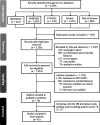Suicidality Among People Living With HIV From 2010 to 2021: A Systematic Review and a Meta-regression
- PMID: 36162070
- PMCID: PMC9553271
- DOI: 10.1097/PSY.0000000000001127
Suicidality Among People Living With HIV From 2010 to 2021: A Systematic Review and a Meta-regression
Abstract
Objective: The association between human immunodeficiency virus (HIV)/AIDS and suicidality is not well understood, partly because of variability in results. This meta-analysis aimed to investigate the predictive value of HIV/acquired immune deficiency syndrome for incident suicidality.
Methods: A literature review was conducted of articles published between January 1, 2010, and October 31, 2021. The following databases were searched: Embase, MEDLINE, CINAHL, Web of Science, and Scopus. The search terms included human immunodeficiency virus (HIV), suicidal behavior, auto mutilation, and self-injurious behavior. Observational studies were screened following a registered protocol, and eligible ones were meta-analyzed and followed by meta-regression.
Results: A total of 43 studies were included in this systematic review, and a meta-regression included 170,234 participants. The pooled prevalence estimates of suicidal ideation, attempted suicide, and deaths by suicide were 22.3%, 9.6%, and 1.7%, respectively. The following significant risk factors for suicide ideation were found: substance use, depression, low quality of life, low social support, without HIV status disclosure, living alone, low level of memory problems, family history of suicide, and stage III of HIV. Risk factors for suicide attempts were depression and family history of suicide. An elevated risk for suicide-related death was found for people living with HIV (PLHIV) who had a psychiatric disorder and in studies conducted in hospital-based settings (versus national database studies or HIV clinic settings).
Conclusions: The risk of suicidality is high among PLHIV within all six World Health Organization regions during the modern antiretroviral therapy era. Assessment of socioeconomic and psychological factors is recommended for further management to prevent suicide among PLHIV. The present findings are useful for design of intervention protocols and development of clinical practice guidelines intended to manage the well-being of PLHIV worldwide.
Copyright © 2022 The Author(s). Published by Wolters Kluwer Health, Inc. on behalf of the American Psychosomatic Society.
Figures






References
-
- World Health Organization . Suicide. 2019. Available at: https://www.who.int/news-room/fact-sheets/detail/suicide.
-
- Lemsalu L Ruutel K Laisaar KT Lohmus L Raidvee A Uuskula A, et al. . Suicidal behavior among people living with HIV (PLHIV) in medical care in Estonia and factors associated with receiving psychological treatment. AIDS Behav 2017;21:1709–16. - PubMed
-
- Keiser O Spoerri A Brinkhof MW Hasse B Gayet-Ageron A Tissot F, et al. . Suicide in HIV-infected individuals and the general population in Switzerland, 1988–2008. Am J Psychiatry 2010;167:143–50. - PubMed
Publication types
MeSH terms
LinkOut - more resources
Full Text Sources
Medical

